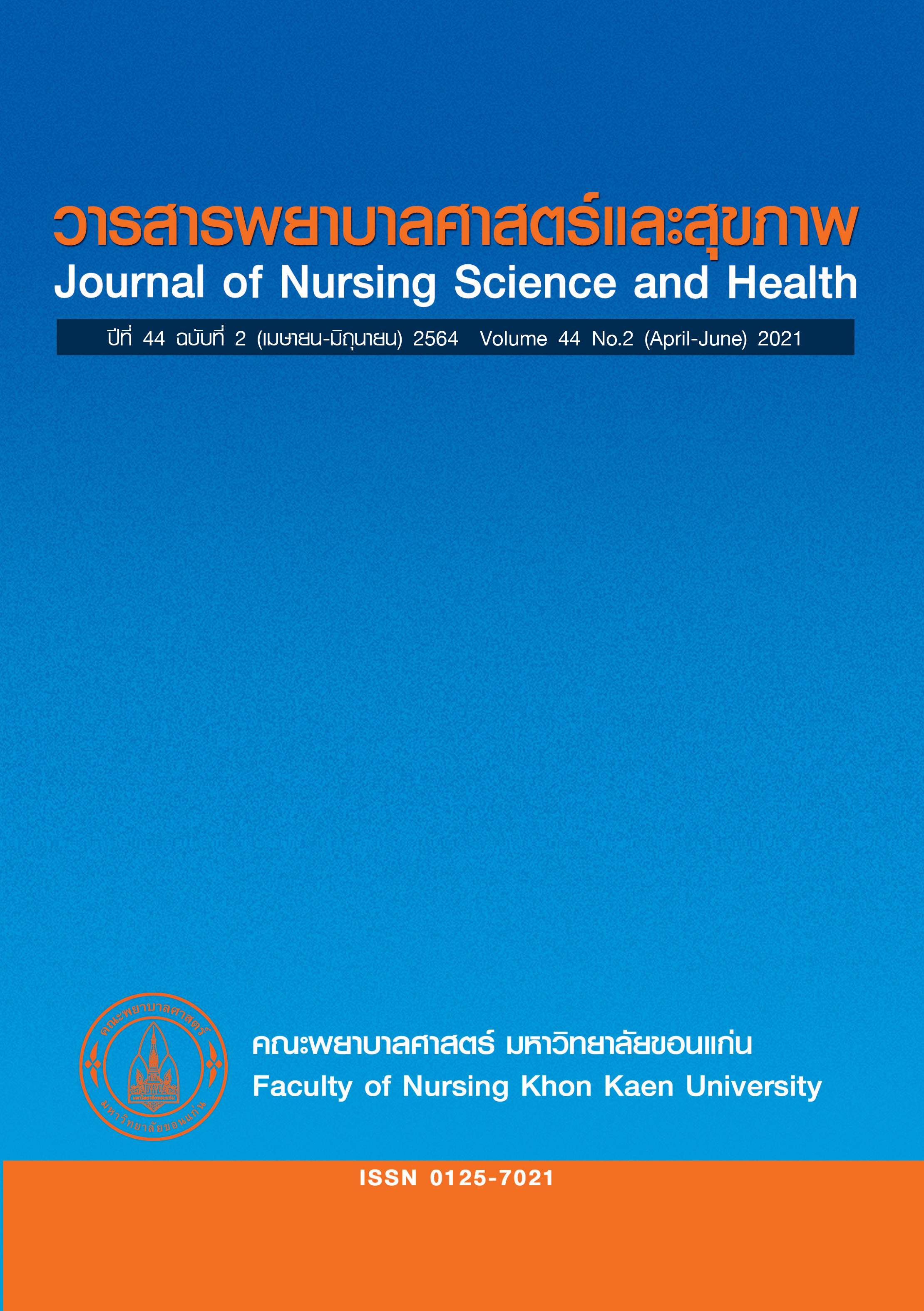ปัจจัยที่เกี่ยวข้องกับการติดของกระดูกในผู้ป่วยกระดูกหน้าแข้งส่วนกลางหัก ที่ได้รับการผ่าตัดใส่เหล็กดาม
คำสำคัญ:
ปัจจัยที่เกี่ยวข้องกับการติดของกระดูก, กระดูกหน้าแข้งส่วนกลางหักบทคัดย่อ
การศึกษาย้อนหลังนี้มีวัตถุประสงค์เพื่อศึกษาปัจจัยที่เกี่ยวข้องกับการติดของกระดูกในผู้ป่วยกระดูกหน้าแข้งส่วนกลางหักที่ได้รับการผ่าตัดในโรงพยาบาลระดับตติยภูมิแห่งหนึ่งในจังหวัดขอนแก่น กลุ่มตัวอย่างเป็นผู้ป่วยกระดูกหน้าแข้งส่วนกลางหักที่ได้รับการรักษาโดยการผ่าตัดใส่เหล็กดามจำนวน 360 ราย คัดเลือกกลุ่มตัวอย่างตามคุณสมบัติภายในระยะเวลาที่กำหนด เครื่องมือที่ใช้ในการวิจัยประกอบด้วย แบบบันทึกข้อมูลส่วนบุคคลและข้อมูลสุขภาพ และแบบบันทึกปัจจัยที่เกี่ยวข้องกับการติดของกระดูก ตรวจสอบความตรงตามเนื้อหาของแบบบันทึกโดยผู้เชี่ยวชาญ 3 ท่าน ได้ค่าดัชนีความตรงตามเนื้อหาเท่ากับ 1 วิเคราะห์ข้อมูลโดยใช้สถิติเชิงบรรยายและ logistic regression analysis
ผลการวิจัยพบว่า ปัจจัยที่เกี่ยวข้องกับการติดของกระดูกในผู้ป่วยกระดูกหน้าแข้งส่วนกลางหักอย่างมีนัยสำคัญทางสถิติ ได้แก่ ลักษณะการแตกหักของกระดูกไม่เกิน 2 ชิ้น (OR Adj = 3.36; 95%CI=1.33 –8.53; p – value=0.011) ลักษณะการแตกหักของกระดูกแบบบางส่วนยังติดกัน (OR Adj =7.51; 95%CI=1.68 - 33.66; p – value=0.008) การบาดเจ็บเพียงตำแหน่งเดียว (OR Adj = 1.97; 95%CI=1.04 - 3.88; p – value=0.048) และการไม่ติดเชื้อ (OR Adj = 10.73; 95%CI=5.18-22.20; p – value < 0.001) ส่วนการสูบบุหรี่ การแตกหักของกระดูกแบบปิด/เปิด ความรุนแรงของการบาดเจ็บเล็กน้อยและระยะเวลารอผ่าตัด มีความเกี่ยวข้องกับการติดของกระดูกอย่างไม่มีนัยสำคัญทางสถิติ
พยาบาลสามารถนำผลการวิจัยไปใช้ในการดูแลผู้ป่วยโดยคำนึงถึงปัจจัยที่เกี่ยวข้อง ที่ควรดูแลอย่างใกล้ชิดและเฝ้าระวังการเกิดภาวะแทรกซ้อนระยะหลังกระดูกหัก ได้แก่ ผู้ป่วยที่มีการแตกหักของกระดูกมากกว่า 2 ชิ้น ผู้ป่วยที่มีการแตกหักของกระดูกที่แยกออกจากกัน ผู้ป่วยที่มีการบาดเจ็บมากกว่า 1 ตำแหน่ง และโดยเฉพาะผู้ป่วยที่มีการติดเชื้อซึ่งพบว่ามีโอกาสเกิดภาวะแทรกซ้อนได้สูง มีการพัฒนาแบบประเมินความเสี่ยงต่อการเกิดภาวะแทรกซ้อนระยะหลังกระดูกหักและพัฒนาแนวปฏิบัติสำหรับการดูแลผู้ป่วยตามระดับความเสี่ยง
เอกสารอ้างอิง
Salminen S. Femeral shaft fracture in adult: Epidemiology, fracture patients, nonunions, and fatigue fracture: A clinical study. Helsinki: The faculty of medicine of university of Helsinki; 2005.
Kulthanan T, Songcharoen P. Orthopedic texts 1. Bangkok: Media Press Limited Partnership; 2008. (in Thai)
Wilairat W. Fractures of the frontal tibia; 2016. Avaiable from: http://ortho.md.chula.ac.th /student/SHEET/ shin-va.pdf.
Kiatkerd A. The effect of the treatment of shin bone fracture by means of metal sheet surgery that causes the least damage to the tissue. Krabi Hospital. Journal of Medical Education Region 2015; (1): 111-8. (in Thai)
Satanawiwat W. Orthopedic nursing. 7th ed. Bangkok: NP Press Limited Partnership; 2010. (in Thai)
Watjanawisit W, Watanarat P, Kitkhunsathien C, Laoharoensombat S, Suphaphol S. Orthopedic 3rd ed compiled. Bangkok: Department of Orthopedic Surgery. Faculty of Medicine Ramathibodi Hospital; 2011. (in Thai)
Mirhadi S, Ashwood N, Karagkevrekis B. Factors influencing fracture healing. Trauma 2013;15(2):140–55.
Bishop JA, Palanca AA, Bellino MJ, Lowenberg DW Assessment of compromised fracture healing. Journal of the American Academy of Orthopaedic Surgeons 2012; 20(5):273–82.
Copuroglu C, Calori GM, Giannoudis PV. Fracture non-union: Who is at risk. Injury 2013; 44(11):1379–82.
Tzioupis C, Giannoudis VP. Prevalence of long bone non-union. Injury, Int. J. care Injured 2007;38(S):S3-9.
Meesters D, Wijnands K, Brink P, Poeze M. Malnutrition and fracture healing: Are specific deficiencies in amino acids important in nonunion development? Nutrients 2018;10(11): 1597.
Tanthadprasert S. Results of treatment of osteomyelitis, fracture, disconnection and infection with Ilizarovring fixator at Udonthani hospital. Medical Journal of Udon Thani Hospital 2018; 26 (2): 119-26. (in Thai)
Metsemakers WJ, Handojo K, Reynders P, Sermon A, Vanderschot P, Nijs S, et al. Individual risk factors for deep infection and compromised fracture healing after intramedullary nailing of tibial shaft fractures: A single centre experience of 480 patients. Injury 2015; 46(4): 740–5.
Iamchanprateep S, Thanarak S, Teepapal T. Planning for the sale of patients with bone and joint problems. NJPH 2018; 27: 9-18. (in Thai)
Rotsinwarangkun W. Factors affecting slow bone in surgical use of metal stud in the bone cavern. Medical Journal of Udon Thani Hospital 2004; 12(3): 158-69. (in Thai)
Ekegren C, Edwards E, Steiger R, Gabbe B. Incidence, costs and predictors of non-union, delayed union and mal-union following long bone fracture. International Journal of Environmental Research and Public Health 2018; 15(12): 2845.
Zura R, Mehta S, Della Rocca GJ, Steen GR. Biological risk factors for nonunion of bone fracture. JBJS 2016; 4(1):01874474-201601000-00005. doi: 10.2106/JBJS.RVW.O.00008
Scolaro JA, Schenker ML, Yannascoli S, Baldwin K, Mehta S, Ahn J, et al. Cigarette smoking increases complications following fracture: A systematic review. JBJS 2014; 96(8): 674–81.
Pearson R G, Clement RGE, Edwards KL, Scammell BE. Do smokers have greater risk of delayed and non-union after fracture, osteotomy and arthrodesis? A systematic review with meta-analysis. BMJ Open 2016; 6(11): e010303.
Hernigou J, Schuind F. Tobacco and bone fractures: A review of the facts and issues that every orthopaedic surgeon should know. Bone & Joint Research 2019; 8(6): 255–65.
Elmali N, Ertem K, Ozen S, Inan M, Baysal T, Güner G, et al. A fracture healing and bone mass in rats fed on liquid diet containing ethanol alcoholism: Clinical and Experimental Research 2002; 26(4): 509–13.
Natoli RM, Yu H, Meislin MC-M, Abbasnia P, Roper P, Vuchkovska A, et al. Alcohol exposure decreases osteopontin expression during fracture healing and osteopontin-mediated mesenchymal stem cell migration in vitro. Journal of Orthopaedic Surgery and Research 2018; 13: 101. https://doi.org/10.1186/s13018-018-0800-7
Wu KJ, Li SH, Yeh KT, et al. The risk factors of nonunion after intramedullary nailing fixation of femur shaft fracture in middle age patients. Medicine 2019; 98(29):e16559.
Santolini E, West R, Giannoudis PV. Risk factors for long bone fracture non-union: A stratification approach based on the level of the existing scientific evidence. Injury 2015; 46: S8–19.
ดาวน์โหลด
เผยแพร่แล้ว
รูปแบบการอ้างอิง
ฉบับ
ประเภทบทความ
สัญญาอนุญาต
วารสารพยาบาลศาสตร์และสุขภาพเป็นเจ้าของลิขสิทธิ์ในการเผยแพร่ผลงานที่ตีพิมพ์ห้ามผู้ใดนำบทความที่ได้รับการตีพิมพ์ในวารสารพยาบาลศาสตร์และสุขภาพไปเผยแพร่ในลักษณะต่าง ๆ ดังนี้ การนำบทความไปเผยแพร่ออนไลน์ การถ่ายเอกสารบทความเพื่อกิจกรรมที่ไม่ใช่การเรียนการสอน การส่งบทความไปตีพิมพ์เผยแพร่ที่อื่น ยกเว้นเสียแต่ได้รับอนุญาตจากวารสารพยาบาลศาสตร์และสุขภาพ



